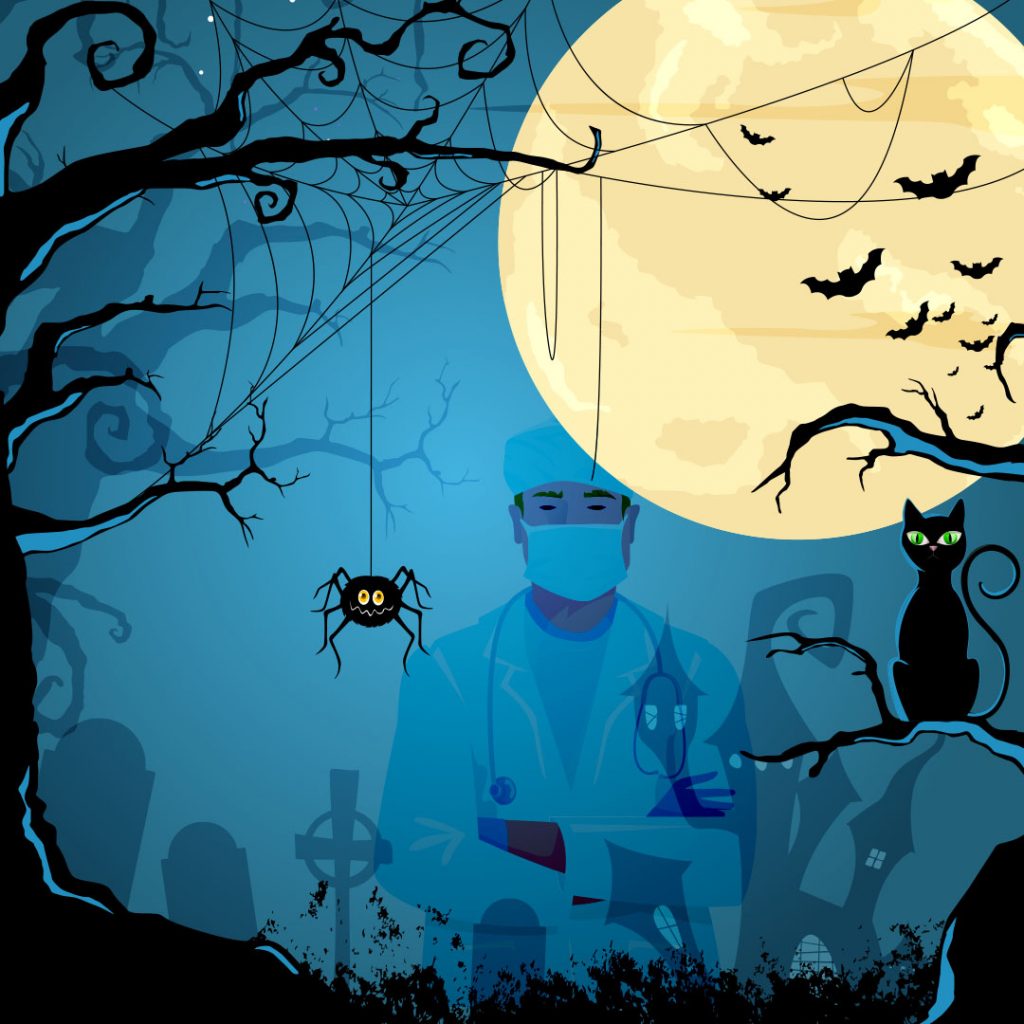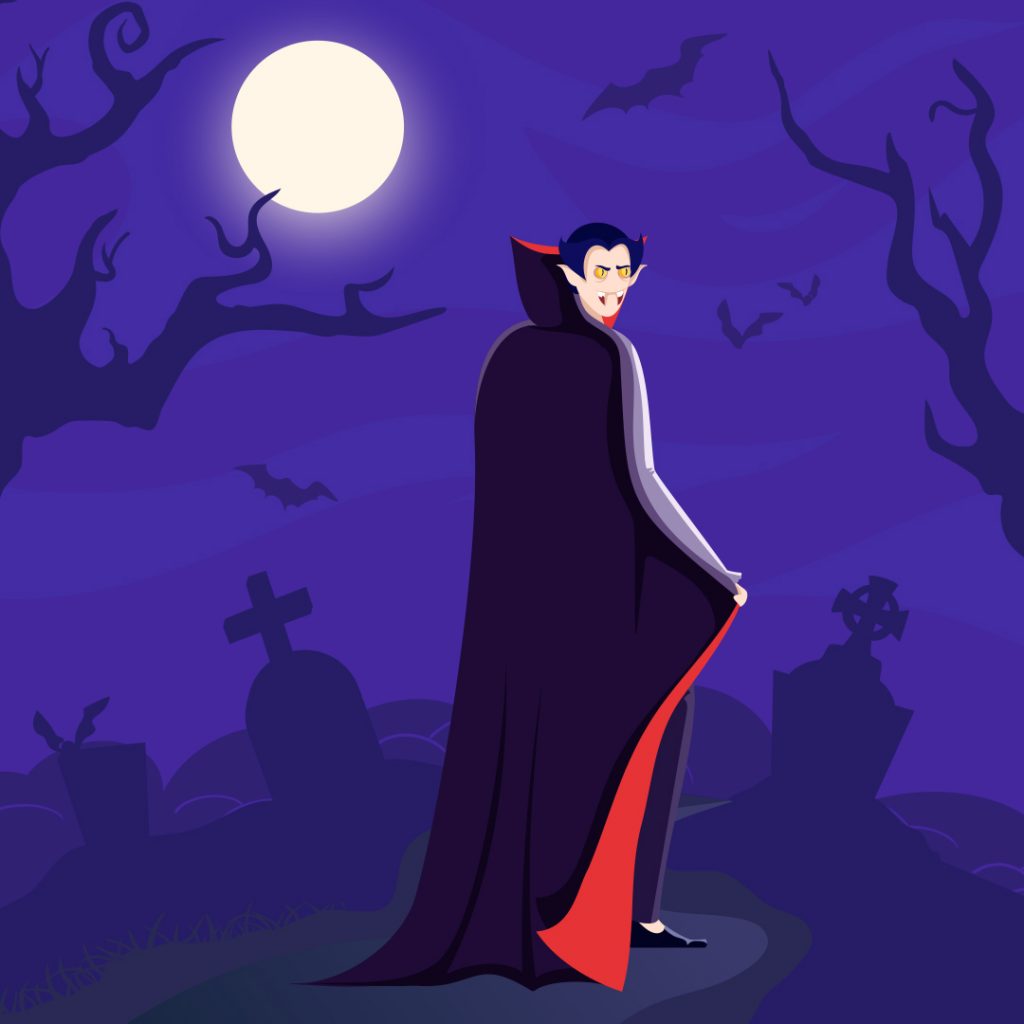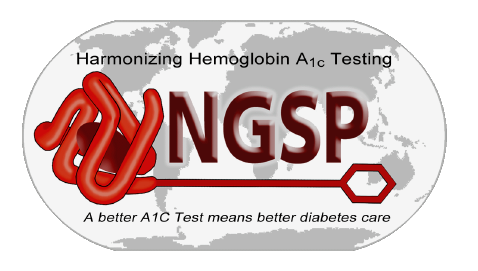Let's talk about Halloween from a medical perspective
The scariest night of the year is approaching and at Hematológico we want to enjoy and learn about it.
Halloween has become, after Christmas, one of the most popular holidays in the world. Every place celebrates the night of the witches in a different way; however, many still do not know, not only the fantastic and traditional origin of Halloween, but also the tangible and scientific explanation of some of the typical horror elements of this holiday.
Although we may believe that the roots of this holiday come from the United States and the modern era, in reality its origin dates back to more than 2000 years ago, with the Celtic tribes that inhabited Great Britain, Ireland and northern France. October 31 marked Samhein, or the end of summer, the last day of their calendar and the beginning of winter. The Celts believed that on this night, before the new year, the spirits of the dead returned to earth. During the celebration, they would disguise themselves to hide from the returning evil spirits.
The use of “triqui-triqui”, (trick or treat) also comes from these beliefs; the living feared that if they did not honor the spirits, witches and goblins that ran free that night, leaving them offerings such as food or candy, these spirits would cause them harm.
On the other hand, not all elements of Halloween and horror come from fantastic elements; in many cases, medical conditions, pharmacological or toxicological reactions can explain cases that at the time were interpreted as supernatural events.
In addition to this, cinema and literature, as a complement to this festivity, have occasionally been inspired by real medical facts to create the horror stories that accompany us every October. Vampires, witches, werewolves and even modern movie characters, such as Freddy Krueger from Nightmare on Elm Street, can be explained from a medical perspective.

Vampire: ¿monster or disease?
Since its first descriptions, the idea of vampires has fascinated mankind. It has been represented in diverse ways in oral tradition, literature and cinema; however, it maintains common characteristics in all of them. Although the best known representation in the West is Count Dracula from Bram Stoker’s eponymous novel, African and Eastern folklore also have vampires, such as sasabonsam from West Africa and manananggal in the Philippines.
Considering the global distribution of this myth, and assessing its characteristics from a medical perspective, similarities have been described with some rare medical conditions, especially with a hematological disorder, porphyria.
The term porphyria is used to name a group of disorders characterized by defects in the enzymes involved in the synthesis of the heme group (an essential structural element of hemoglobin and other proteins in the body). According to the enzyme affected, there are several subtypes of the disease, such as porphyria cutanea tarda, acute intermittent porphyria and congenital erythropoietic porphyria.
The signs and symptoms of congenital erythropoietic porphyria are the ones that have been most associated with vampire lore, as it is characterized by great photosensitivity and severe skin damage from sun exposure, described in the mythical vampires as sun aversion, or destruction by the sun; This causes severe scarring and deformities in the photoexposed areas, the skin of the lips and the mucosa of the gums tightens in such an extreme way that the teeth appear more prominent, like fangs. Patients also present chronic hemolytic anemia, which explains the continuous need to consume blood in the legends. Even the aversion to garlic, commonly used as a defense against vampires, is explained by the ability of some compounds of this plant to induce the degradation of the heme group, which worsens the anemia in the patients.

Other rare diseases that have been associated with legendary descriptions of vampires are pellagra, rabies and hypohidrotic ectodermal dysplasia. In pellagra, caused by niacin and tryptophan deficiency, patients present with high photosensitivity; in addition to tongue erythema and dementia, which manifests with insomnia and aggressiveness. Rabies virus infection, its transmission by bites from animals linked to the vampire tradition such as bats, dogs or wolves, and some of its symptoms such as hydrophobia, aggressiveness and insomnia, is another example. Patients with hypohidrotic ectodermal dysplasia have congenital decreased sweating ability, thin skin and hair, prominent bluish dark circles under the eyes, heat intolerance and small pointed teeth; all these particularities are related to the physical description of vampires.
Given the infrequency of these diseases, the various symptoms not explained by diseases known at the time, the vampire myth was able to feed on descriptions of these patients, giving a supernatural interpretation to real ailments.
Witches: myth, magic and reality
The image of witches and their representation throughout history has changed in numerous instances. From evil, ugly, wicked women with hooked noses and full of warts over a boiling cauldron, to teenagers of hegemonic beauty learning to control their powers, the witch has been in the collective imagination even since the Old Testament.
However, the real history of witches is much darker and, in the case of women accused of being witches, often fatal. Although most of them were simply healers or wise women, gifted with botanical knowledge, they were seen as pagans doing the work of the “devil”. This is why in the Middle Ages mass hysteria against witches invaded Europe and many of them were executed at the stake or by hanging.
In fact, although many of the “potions” and ointments used by the witches had no real effectiveness, some of the medicines used by the facultative medicine have their origin in the cabinet of these women.

Werewolves: folklore versus genetics
Werewolves have been an essential part of legends since ancient times; in tradition they are people who transform into wolves without completely losing the ability to think like humans. Depending on the stories, it has been seen as punishment, curse or inheritance. Science has tried, as in the cases previously described, to explain the logical or scientific basis of these beings, highlighting some conditions that have contributed to the werewolf legend, such as infection by the rabies virus, the porphyria already discussed and some psychiatric diseases in dissociative states (9). However, the human condition that has been most closely linked to the werewolf legend, so much so that it has been called “werewolf syndrome,” is congenital universal hypertrichosis.
Congenital hypertrichosis is a rare genetic disorder characterized by excessive hair growth all over the body, including the face. These people have inherited mutations in some genes that control the growth of hair follicles.
Fewer than 50 cases have been described in history; one of the first in 1556, in a slave from Tenerife who was brought to the French court; two of his sons inherited and passed on the condition. Throughout history, people with hypertrichosis were exhibited as rarities in circuses and courts, and further fueled the werewolf legend.
Lycanthropy, which is not associated with congenital hypertrichosis, is a mental disorder in which the patient believes he/she is a wolf or some other beast; it is a dissociative state that can be associated with psychiatric illnesses such as schizophrenia, depressive or manic psychotic states, and ingestion of some hallucinogenic alkaloids.

Dying in your sleep: cinematic terror inspired by real events
Bibliography
- Cabrera SK. La noche mágica de Samhein [Internet]. La noche mágica de Samhein. 2016 [citado 5 de octubre de 2021]. Disponible en: http://susurrosenlacorte.blogspot.com/2016/10/la-noche-magica-de-samhein.html
- Maas RPPWM, Voets PJGM. The vampire in medical perspective: myth or malady? QJM. 1 de noviembre de 2014;107(11):945-6.
- Vampires & Werewolves in the ED? | Emergency Physicians Monthly [Internet]. 2010 [citado 22 de abril de 2021]. Disponible en: https://epmonthly.com/article/vampires-a-werewolves-in-the-ed/
- King L. LibGuides: Witches: The Myth and Magic [Internet]. [citado 8 de octubre de 2021]. Disponible en: https://westportlibrary.libguides.com/c.php?g=1077329&p=7848802
- Magazine S, Thompson H. How Witches’ Brews Helped Bring Modern Drugs to Market [Internet]. Smithsonian Magazine. [citado 8 de octubre de 2021]. Disponible en: https://www.smithsonianmag.com/science-nature/how-witches-brews-helped-bring-modern-drugs-market-180953202/
- Editors H com. History of Witches [Internet]. HISTORY. [citado 8 de octubre de 2021]. Disponible en: https://www.history.com/topics/folklore/history-of-witches
- Antonio Quesada-Díaz, Ortega-Díaz A. El cornezuelo del centeno a lo largo de la historia: mitos y realidades. Pasaje Cienc. 2011;14:16-25.
- Ergot: from witchcraft to biotechnology. Mol PLANT Pathol. 2009;15.
- Werewolves – a medical perspective [Internet]. [citado 5 de octubre de 2021]. Disponible en: https://www.the-cma.org.uk/articles/werewolves-a-medical-perspective-3791/
- Fantauzzo KA, Kurban M, Levy B, Christiano AM. Trps1 and Its Target Gene Sox9 Regulate Epithelial Proliferation in the Developing Hair Follicle and Are Associated with Hypertrichosis. PLOS Genet. 1 de noviembre de 2012;8(11):e1003002.
- StufftoBlowYourMind.com RL. Actual Sleep Deaths Inspired A Nightmare on Elm Street [Internet]. Tor.com. 2011 [citado 19 de octubre de 2021]. Disponible en: https://www.tor.com/2011/08/05/actual-sleep-deaths-inspired-a-nightmare-on-elm-street/
- Nightmare On Elm Street Was Inspired By A Real Life Medical Mystery [Internet]. IFLScience. [citado 19 de octubre de 2021]. Disponible en: https://www.iflscience.com/health-and-medicine/nightmare-on-elm-street-was-inspired-by-a-real-life-medical-mystery/
- What inspired “A Nightmare on Elm Street” and Freddy Krueger? | Read | The Take [Internet]. What inspired “A Nightmare on Elm Street” and Freddy Krueger? | Read | The Take. 2016 [citado 20 de octubre de 2021]. Disponible en: https://the-take.com/read/what-inspired-a-nightmare-on-elm-street-and-freddy-krueger
- Antzelevitch C. Brugada syndrome: 1992–2002. 2003;41(10):7.



